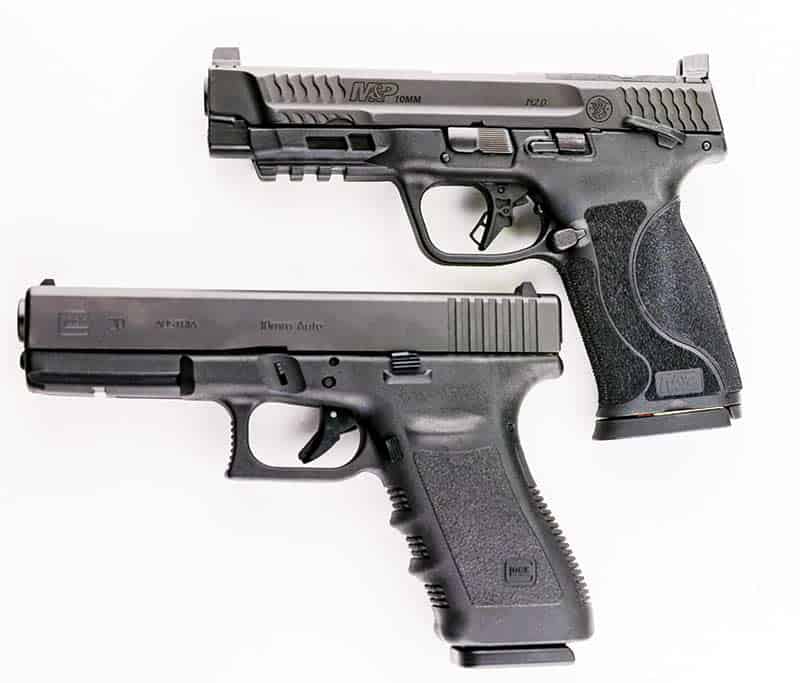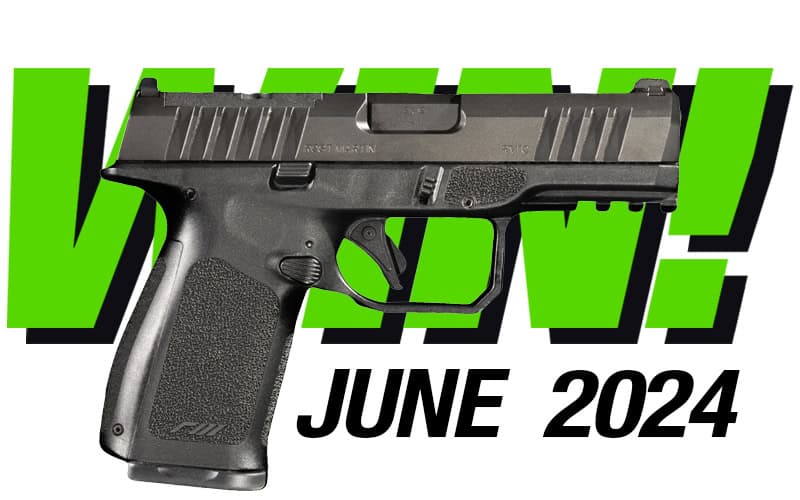Smith & Wesson 10mm M&P
Step Up To The Big Time
The Smith & Wesson Military & Police series of polymer-framed semiautomatic pistols is approaching its 20th year. Having been chambered in 9mm, .40 S&W, .45 ACP, .357 SIG and even .22 Long Rifle, S&W gave us a Christmas present by announcing it in 10mm Auto. Built on the .45 frame, it still has excellent trigger reach along with a number of Gen 2.0 features and some of its own.
Built rugged for the notoriously potent 10mm, it stays relevant to the times with a carry optics cut and a set of mounting plates as standard equipment besides the usual M&P grip-adaptation accessories. Accordingly, it has the high CORE (Competition Optics Ready Equipment) suppressor-type sights to allow co-witnessing through a red dot sight window. It’s not going to “auto-forward” the slide when you slam in a magazine as early 9mm versions did. Like almost all modern service-configuration pistols, it comes with a light rail.
The pistol comes with your choice of 4.0″ or 4.6″ barrel and commensurate length slide, and with or without an ambidextrous frame-mounted thumb safety. Ours was the longer model, complete with thumb safety. They come with two all-steel 15-round magazines. All have usable slide serrations up front, which I can’t recommend but a lot of consumers like.
The grip stippling on our test gun, serial number NKX9963, was aggressive. A tight grasp in dry-fire was moderately uncomfortable, but in rapid fire the pistol didn’t move at all within my grasp — and that’s what the rough stipple is for. Interestingly, once the shooting started, the discomfort disappeared or at least went unnoticed.
Shooting The 10mm M&P
Dunno ’bout y’all, but when testing shooting characteristics, trigger pull is very high up on my list. One selling point S&W is emphasizing on this pistol is its new flat-faced trigger, a trendy thing right now. My friend John Strayer, a Five-Gun Master in IDPA competition and winner of many state and regional championship titles commented, “I got away from the M&P because I didn’t like that two-piece curved trigger, but this is an M&P trigger I like!”
An early complaint with M&P triggers was mushy reset and S&W promises a crisper one on this pistol. Trigger feel is based on sense of touch and thus very subjective, but I didn’t find the reset especially palpable, particularly in rapid fire.
Measured on a Lyman Digital Trigger Gauge, trigger weight averaged 5.418 lbs. at the “toe” or bottom edge of the trigger and 6.175 lbs. from the center, where our finger is actually likely to be. The break was clean. I for one was happy with it.
One thing I’ve never cared for on the M&P was difficulty in hitting the slide release lever on slide-lock reloads, which is indisputably faster than the slide tug method. On this gun, I was happy to find the lever protruded enough to make the faster technique simple and positive. Empty magazines always dropped cleanly and fresh mag insertion was always positive, thanks to the tapered top of the mag and the well-flared magazine well.
I loved those big, high iron sights. They gave an excellent sight picture and drew cleanly from a Leather Arsenal Summer Surprise leather IWB holster built for a Springfield XD45 long-slide with high sights. I could see the high, non-ramped front sight being a snag point in a skeletonized Yaqui Slide type holster, though. The high rear sight worked well against the edge of the belt for emergency one-handed “wounded defender” slide operation.
The thumb safety was reasonably ergonomic and more positive than the ones on some earlier M&Ps. With the popularity of appendix carry, more shooters are appreciating this feature. I’ve documented enough cases where the bad guy got the good guy’s gun and couldn’t shoot him because he couldn’t find “the switch that turns on the gun,” so I appreciate manual safeties. I applaud S&W for giving you the choice.
Recoil? If you’ve shot this type of pistol with .45 ACP +P (185-grain at 1,140 fps) you’ve pretty much shot the 10mm version with a 180-grain 10mm bullet going just a bit faster. The heavier “bear loads,” of course, will kick more. Light training loads will be pussycats by comparison.
As noted earlier, the sharply stippled grip was more help than hurt when shooting. I could see it getting tiresome for a thousand-round-a-day training course, but I don’t know anyone who takes full-power 10mms to those events. Speaking as an elderly cripple, when I go to those things, I go down by, oh, about one millimeter. A thousand rounds of full-power Ten a day isn’t training so much as its Iron Man Competition. Frankly, all on the test team who fired the M&P 10mm found it fun to shoot.
Carry? I wore it for a day in the Leather Arsenal holster. No issues. A T-shirt kept the stippling from being a problem, which I suspect it would have been if carried under the tee and tight against bare skin.
Accuracy
Testing was my standard protocol here: three loads from as many different makers, fired two-handed from a solid Caldwell Matrix rest on a concrete bench at 25 yards. Five-shot groups to see what each gun/load combo would do from experienced hands in perfect, calm conditions, and an additional measurement of the best three with each because testing has shown this closely duplicates what all five would have done from a machine rest.
For a training load, I used 180-grain jacketed truncated cone Sellier & Bellot, rated for 1,165 feet per second (fps) velocity and 544 foot-pounds of energy (fpe). All five went into 4.85″, with four of those in 2.35″ and the best three in 1.60″. All measurements were center-to-center of the bullet holes to the nearest 0.05″.
The personal defense exemplar was Hornady’s Critical Duty round, its hollow cavity filled with a pointy polymer tip. Hornady specs this load at 1,160 fps for its 175-grain payload, designed to be “barrier blind,” delivering 523 fpe at the muzzle. The five-shot group measured 3.45″ while the best three went 2.20″.
Our hunting load was branded as such: Federal Premium Medium Game Trophy Bonded, comprising a 180-grain soft nose semi-jacketed right up to its broad, flat meplat. Federal specifies 1,275 fps and 650 fpe for this round. It proved to be the most accurate of the test. The whole five shots formed a 2.55″ group, four of those being in 1.45″ and the tightest trio measuring a mere eight-tenths of one inch.
All grouped left. The aforementioned John Strayer was the first of us to diagnose why. The front sight was definitely right of center in its dovetail. I can’t blame S&W for this for sure. The test gun had been well used before it got to me, as witness some smutz on one of the magazines, and a previous tester may simply have moved the sight because he or she was shooting to the right. Drifting it in the dovetail is an easy fix in any case. The sights were dead nuts-on for elevation with the Federal load, and pretty close for the other two.
Bottom Line
Everyone who shot our test 10mm M&P liked it. With ambi slide stop, safety levers and reversible magazine release, the pistol proved totally southpaw-friendly. The ammo drought prevented a marathon torture test, but with three figures worth of “mild to wild” 10mm through it, we experienced 100% reliability.
If you’re looking to find out what the resurgence of the 10mm pistol is all about, the M&P is a good place to start and a good value at $665 MSRP for the variation we tested.









